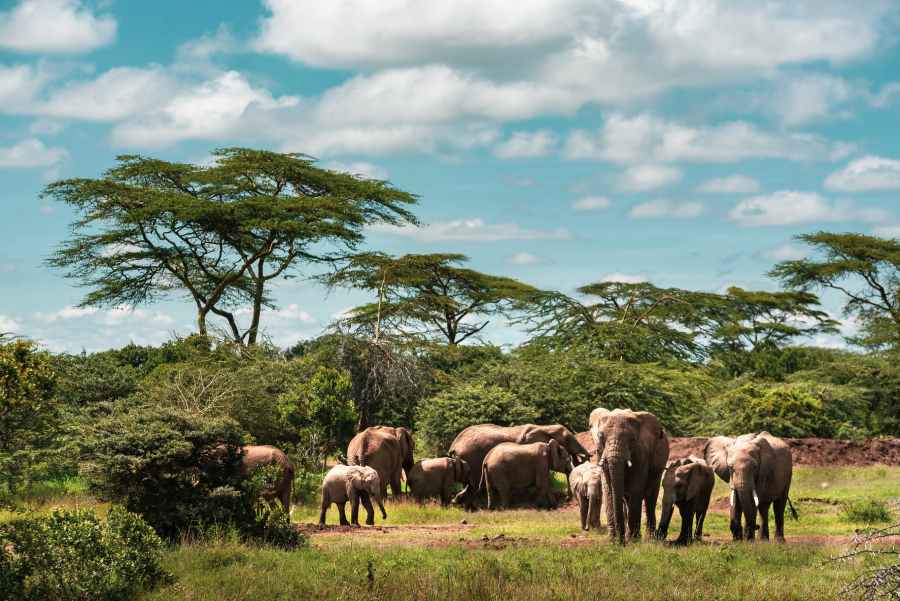 Tanzania is home to some of the most unique and beautiful places on Earth. Over 30% of the country consists of National Parks or conservation areas, many of which have been named World Heritage Sites. From towering mountains and volcanic calderas to vast grasslands and large populations of diverse wildlife, the list of things to see and do can seem as endless as the plains of the Serengeti. Fortunately, we’ve put together a list of Tanzania’s Top 5 National Parks and what makes each one of them so special.
Tanzania is home to some of the most unique and beautiful places on Earth. Over 30% of the country consists of National Parks or conservation areas, many of which have been named World Heritage Sites. From towering mountains and volcanic calderas to vast grasslands and large populations of diverse wildlife, the list of things to see and do can seem as endless as the plains of the Serengeti. Fortunately, we’ve put together a list of Tanzania’s Top 5 National Parks and what makes each one of them so special.
Serengeti National Park
The Serengeti, which means “the place where the land runs on forever”, was named by the local Maasai people who originally called the grasslands their home. With nearly 5,700 sq mi of savanna stretching from horizon to horizon, it 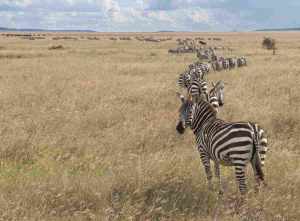 can feel as vast and endless as an ocean. The Serengeti is Tanzania’s oldest national park and definitely the most famous, home to a vast array of wildlife. People from all over the world travel here to witness the Great Migration, a yearly event in which millions of wildebeest, zebra, and gazelles travel across the plains in search of freshwater and food. They are closely pursued on their journey by hungry predators like the cheetah, the hyena, and the crocodile. The Great Migration is an event unlike any other on Earth and has been named one of the Seven Natural Wonders of Africa.
can feel as vast and endless as an ocean. The Serengeti is Tanzania’s oldest national park and definitely the most famous, home to a vast array of wildlife. People from all over the world travel here to witness the Great Migration, a yearly event in which millions of wildebeest, zebra, and gazelles travel across the plains in search of freshwater and food. They are closely pursued on their journey by hungry predators like the cheetah, the hyena, and the crocodile. The Great Migration is an event unlike any other on Earth and has been named one of the Seven Natural Wonders of Africa.
The dramatic sights and sounds of the Great Migration in the Serengeti National Park create an unparalleled experience for visitors seeking an intimate connection with the untamed African wilderness. As the seemingly endless herds of wildebeest, zebra, and gazelles move in a synchronized dance across the golden savanna, the predators lurking on the peripheries of the migration add an element of suspense and raw natural power to the spectacle. Witnessing the survival tactics and raw beauty of nature played out on this grand stage leaves a lasting impression on all who are fortunate enough to behold it. The Serengeti’s allure lies not only in its sweeping vistas and diverse wildlife but also in the profound sense of wonder and respect it instills in those who venture into its wild heart.
Masai Mara National Park
As you travel north through the Serengeti the land begins to change. The endless plains give way to a land that is 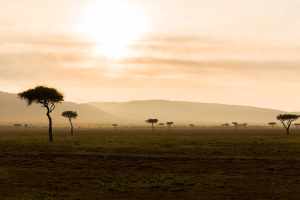 dotted with umbrella-shaped acacia trees. This speckled landscape was named Mara, meaning spotted in the local Maasai language. While technically part of Kenya, it is connected to the Serengeti and is an important part of the yearly Great Migration. You can find the famed “big five” here—elephant, Cape buffalo, leopard, lion and the black rhino. The Maasai, a once-nomadic people who traveled throughout Kenya and Tanzania, now live in and around the Seregenti and the Masai Mara parks. They have held onto their traditional way of life and often welcome visitors to come and learn about their unique culture.
dotted with umbrella-shaped acacia trees. This speckled landscape was named Mara, meaning spotted in the local Maasai language. While technically part of Kenya, it is connected to the Serengeti and is an important part of the yearly Great Migration. You can find the famed “big five” here—elephant, Cape buffalo, leopard, lion and the black rhino. The Maasai, a once-nomadic people who traveled throughout Kenya and Tanzania, now live in and around the Seregenti and the Masai Mara parks. They have held onto their traditional way of life and often welcome visitors to come and learn about their unique culture.
Continuing north through the Serengeti, the landscape gradually transforms into a mesmerizing tapestry of golden savannah that stretches as far as the eye can see. The Mara River, a lifeline for the wildlife that call this region home, winds its way through the grasslands, offering a vital water source for the abundant herds that traverse these plains. Wildebeest, zebra, and gazelle dot the horizon, their movements synchronized in a delicate dance of survival and instinct. As the sun begins its slow descent, casting a warm glow over the savannah, the nocturnal creatures of the Mara awaken, preparing for the night ahead. The symphony of nature’s sounds fills the air, creating a sense of harmony that is both primal and awe-inspiring.
Arusha National Park
Often overlooked by tourists, Arusha National Park is one of the smallest national parks included in Tanzania’s 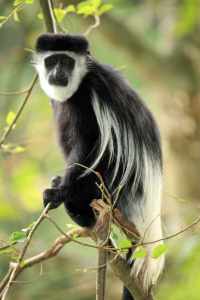 Northern Safari Circuit. While it’s not as large as the Serengeti, it has a unique ecology all of its own. Within its 85 square miles of land, it is home to Mount Meru, an active volcano second in height only to the great Kilimanjaro. Nearby, you’ll find the Ngurdoto Crater, also known as the “Little Serengeti”. While it’s a little less than 2 miles wide, this grassland is filled with buffalo, bush-bucks, warthog, giraffe, and zebra. But what truly sets Arusha apart from the other national parks is its large concentration of rare black-and-white colobus monkeys that live in the forest surrounding the crater. Leaping up to 50 feet from branch to branch, using their thick black and white mantle of fur like a parachute, these beautiful creatures make this park one of the must-see places in Tanzania!
Northern Safari Circuit. While it’s not as large as the Serengeti, it has a unique ecology all of its own. Within its 85 square miles of land, it is home to Mount Meru, an active volcano second in height only to the great Kilimanjaro. Nearby, you’ll find the Ngurdoto Crater, also known as the “Little Serengeti”. While it’s a little less than 2 miles wide, this grassland is filled with buffalo, bush-bucks, warthog, giraffe, and zebra. But what truly sets Arusha apart from the other national parks is its large concentration of rare black-and-white colobus monkeys that live in the forest surrounding the crater. Leaping up to 50 feet from branch to branch, using their thick black and white mantle of fur like a parachute, these beautiful creatures make this park one of the must-see places in Tanzania!
Apart from its breathtaking wildlife and stunning landscapes, Arusha National Park offers a range of activities for visitors seeking adventure and relaxation alike. The park provides opportunities for guided hikes, bird watching, and canoeing on the Momella Lakes, where flamingos and hippos can often be spotted. For the more adventurous travelers, scaling Mount Meru is a challenging yet rewarding trek, offering panoramic views of the park and even glimpses of Mount Kilimanjaro in the distance on a clear day. If relaxation is more your speed, picnicking in the lush surroundings or enjoying a peaceful sunset at one of the designated viewpoints within the park can be the perfect way to unwind after a day of exploration. With its diverse offerings and unique experiences, Arusha National Park truly stands out as a gem worth exploring for any nature enthusiast.
Tarangire National Park
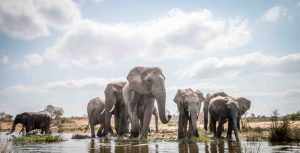 Known for having the highest concentrations of elephant herds in the world and for the beautiful baobab trees that dot its dry landscape, Tarangire National Park is a popular stop on the safari circuit. Its name comes from the Tarangire River, which has carved beautiful valley landscapes and is a vital water source for animals during the dry season. Herds of up to 300 elephants are often gathered near the river to drink and to eat the bark off of the thick trunks of the baobab trees. Legend has it that these oddly-shaped, yet iconic, trees displeased an ancient deity, who then ripped them from the ground and replanted them upside down with their roots pointed to the sky.
Known for having the highest concentrations of elephant herds in the world and for the beautiful baobab trees that dot its dry landscape, Tarangire National Park is a popular stop on the safari circuit. Its name comes from the Tarangire River, which has carved beautiful valley landscapes and is a vital water source for animals during the dry season. Herds of up to 300 elephants are often gathered near the river to drink and to eat the bark off of the thick trunks of the baobab trees. Legend has it that these oddly-shaped, yet iconic, trees displeased an ancient deity, who then ripped them from the ground and replanted them upside down with their roots pointed to the sky.
The diverse ecosystem of Tarangire National Park is not only home to the impressive elephant herds and iconic baobab trees but also supports a wide variety of other wildlife species. As you venture deeper into the park, you may encounter graceful giraffes nibbling on acacia leaves, stealthy predators like lions and leopards seeking their next meal, or even a multitude of colorful bird species decorating the skies. The park offers a unique opportunity to witness the intricate balance of nature as each species plays its part in this vibrant wilderness. Whether basking in the golden sunlight of the savannah or witnessing the spectacular sight of a herd of elephants crossing the Tarangire River, every moment spent in this mesmerizing park is sure to leave a lasting impression.
Ngorongoro National Park
The Ngorongoro crater, a UNESCO world heritage site within the Ngorongoro Conservation Area, is the collapsed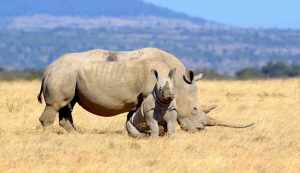 caldera of an ancient volcano and the largest unbroken caldera in the world. Inside the crater rim, surrounded by lush green vegetation, lies golden grasslands filled with over 25,000 animals. This includes the densest known population of lions in all of Africa and the critically endangered black rhinoceros. With less than 6,000 black rhinos left in the world, the Ngorongoro Crater is one of the best places to view these majestic animals in their natural habitat.
caldera of an ancient volcano and the largest unbroken caldera in the world. Inside the crater rim, surrounded by lush green vegetation, lies golden grasslands filled with over 25,000 animals. This includes the densest known population of lions in all of Africa and the critically endangered black rhinoceros. With less than 6,000 black rhinos left in the world, the Ngorongoro Crater is one of the best places to view these majestic animals in their natural habitat.
Tanzania’s diverse landscape and wildlife population makes it one of the most beautiful places on Earth. Words can’t do justice to the experience of actually seeing it in person. Gondwana Ecotours offers two different tours and both include visits to all five parks! One is a camping safari that is surprisingly affordable and includes staff that set up your tents and cook meals for the group. The other safari is more upscale and includes full service stays at luxury lodges. Check out our tour pages for more information on these two unique safaris to Tanzania’s top 5 national parks!



